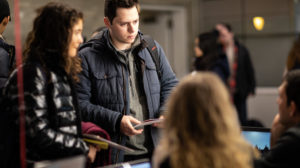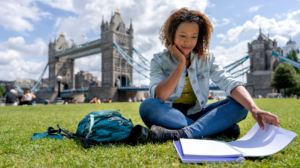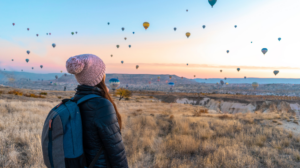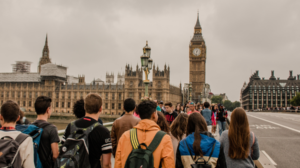It’s September 2021, and I’m walking around Santa Maria Ara Coeli. It’s my first Art History class in Rome, and my whole class is standing around the Bufalini Chapel, which depicts the life of St. Bernardino. Our professor discusses the frescos style and the importance of side chapels, and the story being told in the painting, interweaving history and religion.
Bufalini Chapel, by Pinturicchio (1486)
When I envisioned myself on study abroad, I was eating gelato in front of the Trevi Fountain, meeting new friends from all over the world, and traveling to different countries on the weekends. Don’t get me wrong, I was looking forward to taking classes in a new academic environment in another country, but all of the “once-in-a-lifetime opportunities,” like the experiences I’d have and the places I’d see were at the top of my mind. However, looking back, my classes were a crucial part of my time abroad. The classes I took really supplemented my experience and helped me understand the history, politics, and culture of the country I was living in.
Classes in Italy
During my first two years at Northeastern, I mainly took the required classes for my major, so I’d have more flexibility in picking classes for study abroad. This was helpful because it allowed me to sign up for classes that really interested me and to create a schedule that worked best for me. The school I attended (John Cabot University) didn’t have any classes on Friday, so I made a schedule where I only had classes Monday-Wednesday. With Thursdays off, I gave myself a four-day weekend every week! Additionally, I wanted to take classes that I could only take in Rome. I could take macroeconomics or public speaking anywhere, but taking Renaissance art and Italian culture in its own country would truly enhance the experience.
I ended up taking five classes while abroad: Renaissance Rome and Its Monuments (an art history class), Contemporary Italian Society, Religion and Global Politics, Genocide, and Italian Politics and Society. Some classes I took as electives for my International Affairs major, but the rest were straight electives. Even the classes I took for my major, like Religion and Global Politics, brought Italy into the curriculum. In one unit, we learned about the influence of the Catholic Church on Italian politics, which overlapped with what I was learning in some of my other classes. I’ll never forget the field trip we took to hear Angela Merkel and Pope Francis speak at the Colosseum. The organization, Community of Sant’Egidio, was hosting a meeting for peace, and many influential leaders attended. I remember listening to their speeches and thinking how special it was that I got to be there. It was truly a once-in-a-lifetime opportunity.
Connecting My Classes to The US
As a political science minor, I’ve taken many political classes. I love learning about political parties, legal systems, and the political histories of other countries. So, I was looking forward to doing a deep dive into Italian politics for the semester. It was fascinating to learn more about Italy’s role in World War II, Mussolini, and fascism. For my final paper, I researched the legacy of fascist architecture on contemporary Italian politics and society. It was interesting to see the comparisons (and differences) between Italy and its fascist monuments and the U.S. and its confederate statutes. Learning about how another country deals with its shameful past helped me to understand my country’s history through a new lens. The same can be said when we learned about Italian populism and leaders like Giorgia Meloni (who became Prime Minister in 2022) and Matteo Salvini, which put the rise of populism in the U.S. into a global perspective for me.
There are common stereotypes Americans have of Italy and Italians largely due to the movie industry and mass media, which I was able to deconstruct in my Italian culture class. We learned about the mafia, the influence of Communism, and the refugee crisis. We also learned about Italian neorealism, economic hardships and recoveries, and gender roles. I’m glad I took an Italian politics class and an Italian culture class since politics and culture are so interconnected. Learning more about Italian politics helped me understand Italian culture, and learning about Italian culture helped me understand Italian politics.
While in Italy, I bought a copy of My Brilliant Friend by Elena Ferrante, the first in a series known as the Neapolitan Quartet. These books follow the lives of two best friends in Naples, starting in the 1950s and continuing into the 21st century. I read the book almost a year after coming home, and everything I learned in my classes came rushing back. The information I learned in my classes helped me understand the context of the book and many of the political and cultural references. It was cool to read about places I’d been to, but even cooler (and rewarding) to recognize the names of political leaders and movements I’d learned about (and not have to google them!). Elena Ferrante has become one of my favorite authors, and reading her books, which are all mostly set in Italy, transports me back there.

Reading Elena Ferrante’s The Days of Abandonment in Puerto Rico (December 2022)
I’m so happy I gave myself the time to thoroughly plan out my class schedule. For anyone currently planning their schedule for study abroad, I recommend taking classes related to the country you’re in. I looked forward to my classes every day since the content was genuinely interesting to me. The courses I took made the study in study abroad as fun as the abroad part.
Don’t forget to meet with your academic advisor to ensure the credit for your classes will transfer to Northeastern!











